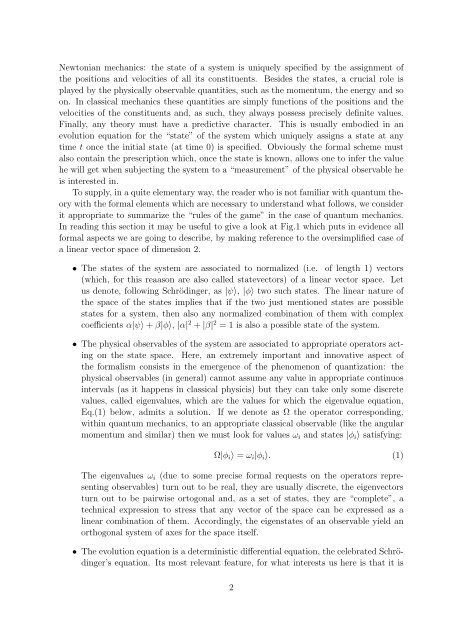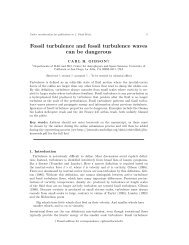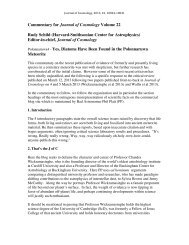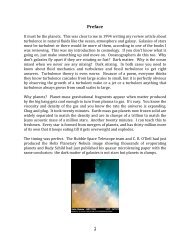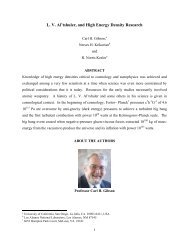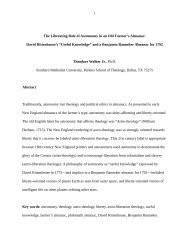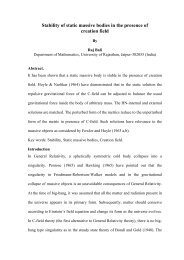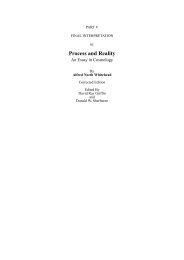The Macro-Objectification Problem and Conscious Perceptions
The Macro-Objectification Problem and Conscious Perceptions
The Macro-Objectification Problem and Conscious Perceptions
You also want an ePaper? Increase the reach of your titles
YUMPU automatically turns print PDFs into web optimized ePapers that Google loves.
Newtonian mechanics: the state of a system is uniquely specified by the assignment of<br />
the positions <strong>and</strong> velocities of all its constituents. Besides the states, a crucial role is<br />
played by the physically observable quantities, such as the momentum, the energy <strong>and</strong> so<br />
on. In classical mechanics these quantities are simply functions of the positions <strong>and</strong> the<br />
velocities of the constituents <strong>and</strong>, as such, they always possess precisely definite values.<br />
Finally, any theory must have a predictive character. This is usually embodied in an<br />
evolution equation for the “state” of the system which uniquely assigns a state at any<br />
time t once the initial state (at time 0) is specified. Obviously the formal scheme must<br />
also contain the prescription which, once the state is known, allows one to infer the value<br />
he will get when subjecting the system to a “measurement” of the physical observable he<br />
is interested in.<br />
To supply, in a quite elementary way, the reader who is not familiar with quantum theory<br />
with the formal elements which are necessary to underst<strong>and</strong> what follows, we consider<br />
it appropriate to summarize the “rules of the game” in the case of quantum mechanics.<br />
In reading this section it may be useful to give a look at Fig.1 which puts in evidence all<br />
formal aspects we are going to describe, by making reference to the oversimplified case of<br />
a linear vector space of dimension 2.<br />
• <strong>The</strong> states of the system are associated to normalized (i.e. of length 1) vectors<br />
(which, for this reaason are also called statevectors) of a linear vector space. Let<br />
us denote, following Schrödinger, as |ψ〉, |φ〉 two such states. <strong>The</strong> linear nature of<br />
the space of the states implies that if the two just mentioned states are possible<br />
states for a system, then also any normalized combination of them with complex<br />
coefficients α|ψ〉 + β|φ〉, |α| 2 + |β| 2 = 1 is also a possible state of the system.<br />
• <strong>The</strong> physical observables of the system are associated to appropriate operators acting<br />
on the state space. Here, an extremely important <strong>and</strong> innovative aspect of<br />
the formalism consists in the emergence of the phenomenon of quantization: the<br />
physical observables (in general) cannot assume any value in appropriate continuos<br />
intervals (as it happens in classical physicis) but they can take only some discrete<br />
values, called eigenvalues, which are the values for which the eigenvalue equation,<br />
Eq.(1) below, admits a solution. If we denote as Ω the operator corresponding,<br />
within quantum mechanics, to an appropriate classical observable (like the angular<br />
momentum <strong>and</strong> similar) then we must look for values ωi <strong>and</strong> states |φi〉 satisfying:<br />
Ω|φi〉 = ωi|φi〉. (1)<br />
<strong>The</strong> eigenvalues ωi (due to some precise formal requests on the operators representing<br />
observables) turn out to be real, they are usually discrete, the eigenvectors<br />
turn out to be pairwise ortogonal <strong>and</strong>, as a set of states, they are “complete”, a<br />
technical expression to stress that any vector of the space can be expressed as a<br />
linear combination of them. Accordingly, the eigenstates of an observable yield an<br />
orthogonal system of axes for the space itself.<br />
• <strong>The</strong> evolution equation is a deterministic differential equation, the celebrated Schrödinger’s<br />
equation. Its most relevant feature, for what interests us here is that it is<br />
2


